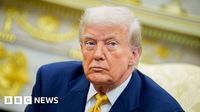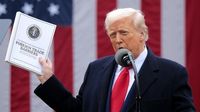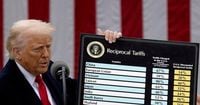On August 29, 2025, a pivotal legal decision reverberated through Washington and the global economy as the U.S. Court of Appeals for the Federal Circuit ruled that President Donald Trump’s sweeping tariff policy was largely illegal. The 7-4 decision, delivered from the nation’s capital, struck at the heart of Trump’s signature trade strategy and set the stage for a high-stakes Supreme Court showdown that could reshape the boundaries of presidential power over U.S. trade policy.
The court’s ruling comes in response to a series of executive orders issued by Trump in April 2025, which imposed a baseline 10% tariff on nearly every country in the world and introduced higher "reciprocal" tariffs on dozens of trading partners. According to BBC, these tariffs extended to key U.S. allies and rivals alike, including China, Mexico, Canada, Brazil, and India. Trump’s justification rested on the International Emergency Economic Powers Act of 1977 (IEEPA), a law designed to empower the president to act against "unusual and extraordinary" threats during national emergencies.
Trump declared a national emergency on trade, arguing that the U.S. trade deficit constituted an existential threat to national security. He dubbed the day the tariffs were announced "Liberation Day," signaling a dramatic break from what he called unfair trade practices. Yet, as Al Jazeera reports, global markets stumbled in the immediate aftermath of the announcement, with critics warning that such deficits can actually reflect economic strength or currency differences rather than a looming crisis.
While Trump’s administration quickly paused the new tariffs for nearly every country except China, the White House maintained that the import taxes were necessary leverage in ongoing negotiations. In the months that followed, a new slate of individualized, country-specific tariffs was unveiled. On August 1, 2025, a 50% tariff hit Brazil, in response to its prosecution of Trump ally and former president Jair Bolsonaro. Just weeks later, India was slapped with a 50% tariff due to its purchase of oil from Russia. Mexico, Canada, and China, meanwhile, continued to face tariff threats, with Trump linking these taxes to compliance with his policies on border security and the fight against fentanyl trafficking.
The legal battle over these tariffs began almost immediately. Lawsuits were filed by the nonpartisan Liberty Justice Center on behalf of five small U.S. businesses, as well as a coalition of 12 states, many led by Democrats. Their argument, echoed by the U.S. Court of International Trade in May, was that Trump had overstepped his authority by imposing universal tariffs—an action that, under the Constitution, falls squarely within the powers of Congress, not the president.
The appellate court’s 127-page decision left little doubt about its stance. “The statute bestows significant authority on the President to undertake a number of actions in response to a declared national emergency,” the court wrote, but “none of these actions explicitly include the power to impose tariffs, duties, or the like, or the power to tax.” The ruling went further, stating, “It seems unlikely that Congress intended, in enacting IEEPA, to depart from its past practice and grant the President unlimited authority to impose tariffs.”
Importantly, the court’s decision does not take effect immediately. To provide time for the Trump administration to appeal to the Supreme Court, the tariffs will remain in place until October 14, 2025. This delay, as BBC notes, gives the administration a crucial window to argue its case before the nation’s highest court—a court that now includes three justices appointed by Trump himself.
Trump’s response was characteristically defiant. On his social media platform, Truth Social, he declared, “ALL TARIFFS ARE STILL IN EFFECT! Today a Highly Partisan Appeals Court incorrectly said that our Tariffs should be removed, but they know the United States of America will win in the end.” He added, “If these Tariffs ever went away, it would be a total disaster for the Country. It would make us financially weak, and we have to be strong.” Trump also expressed confidence that the Supreme Court would ultimately back his position, writing, “Now, with the help of the United States Supreme Court, we will use them to the benefit of our Nation.”
Attorney General Pam Bondi echoed Trump’s sentiments, vowing to appeal and arguing that the ruling “undermines the United States on the world stage” and interferes with the president’s “vital and constitutionally central role in foreign policy.” Meanwhile, lawyers for the White House warned that invalidating the tariffs could trigger a 1929-style financial collapse, citing the possibility of a stock market crash reminiscent of the Great Depression. They argued, “Suddenly revoking the President's tariff authority under IEEPA would have catastrophic consequences for our national security, foreign policy, and economy.”
Critics, however, have long questioned both the legal and economic wisdom behind Trump’s tariff-first approach. Many economists caution that such broad tariffs risk slowing economic growth and raising consumer prices. Some of Trump’s early moves rattled financial markets, though major stock indices have since rebounded. Legal scholars point out that the IEEPA has historically been used to impose sanctions rather than tariffs, and that the law does not explicitly mention tariffs or provide the procedural safeguards necessary for such sweeping economic actions.
The appellate court’s decision also raises significant questions about the scope of presidential authority and the so-called “major questions doctrine,” which holds that Congress must give clear authorization for federal agencies—or the president—to decide issues of major political or economic significance. As The New York Times observes, the Supreme Court has recently taken a skeptical view toward presidents who attempt to implement sweeping new policies without explicit Congressional approval, invalidating both Democratic and Republican initiatives that stretched existing laws to new purposes.
Notably, the court’s ruling does not affect tariffs on steel and aluminum, which were imposed under different presidential authority. It also leaves open the possibility that some country-specific deals, struck after the initial tariffs were announced, could be revisited depending on the Supreme Court’s eventual decision.
For now, the fate of Trump’s tariff regime—and the broader question of presidential power over trade—rests with the Supreme Court. With six Republican appointees, including three chosen by Trump, the outcome is far from certain. As the legal and political drama unfolds, businesses, trading partners, and consumers around the world are watching closely, waiting to see whether the next chapter will bring relief, upheaval, or yet another twist in America’s ongoing trade wars.
The coming months promise a legal battle with profound implications not just for the U.S. economy, but for the very structure of American government and its place in a rapidly shifting global order.


